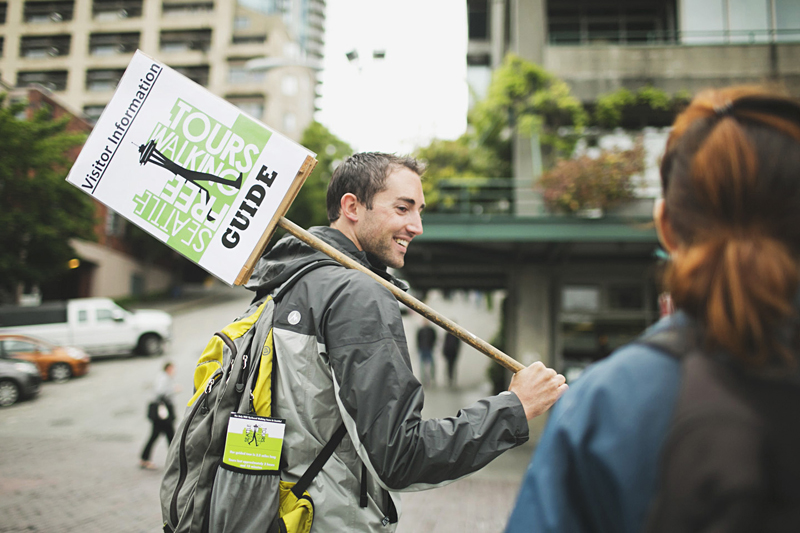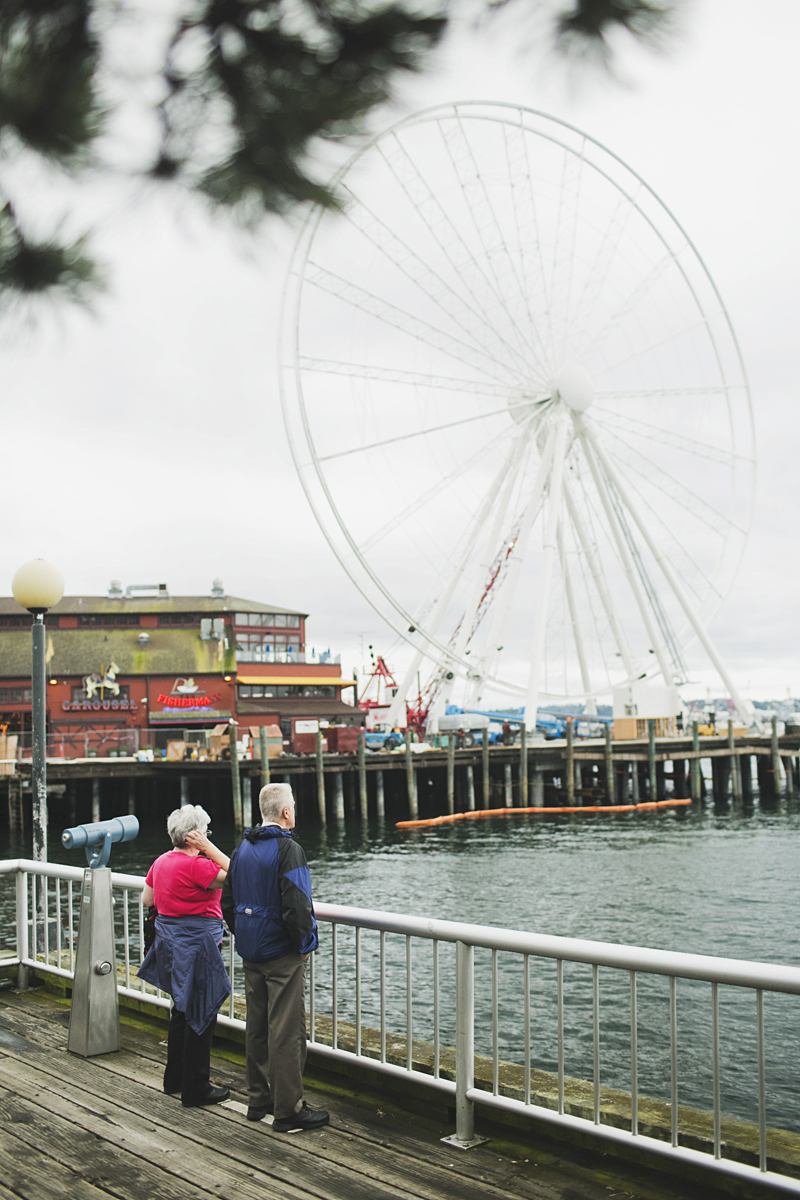The weather for a walking tour, this May morning, is like we’d ordered it off a menu: brilliant sunshine and about 65 degrees, not too warm for the two-and-a-quarter-hour hike ahead of us. Jake Schlack, proprietor and upbeat conductor of Seattle Free Walking Tours, stands in Victor Steinbrueck Park with Don and Kathy, 50ish, from Maryland. With his business partner Nathan Haslip, Jake launched SFWT just this spring, inspired by the similar walking tours in European cities he discovered on his honeymoon. They run (entirely on donation, $15 suggested) daily—except legal holidays—at 11 a.m. (See seattlefree walkingtours.org.)
Jake says about 75 percent of his walkers are from overseas, and some days as many as 30 show up. It’s just us four today, though, and we head through Pike Place Market. Our first stop is the “original” Starbucks (it isn’t really, Jake confides), with the since-phased-out bare-bosom logo. Even more distracting than mermaid boobs is the scent of chocolate and cinnamon rolls from a nearby storefront. We head through Post Alley, named for its yard-high hitching posts, relics of Seattle’s horse-drawn past. We stop at a produce booth for pear slices and one-liners from Claudia—”fresh fruit, fresher personality”—and cross over to pasta maker Pappardelle’s for a taste of chocolate linguini. Jake is well equipped with Market historical anecdotes and tourist info, like its 1907 founding and 1960s rescue from an urban-renewal project. (Imagine how ugly that proposed office/condo space would be today.)
We enjoy smoked salmon from the Pike Place Fish Company—you know them as the fish-throwers—then head down to the Gum Wall, America’s most revolting tourist attraction. There are no samples, unfortunately, at Pike Pub & Brewery, but something even better: an animated overview of the art and history of beer making from the lean and voluble Abil Bradshaw. The brewery specializes in British and Belgian ales, producing around 9,500 barrels a year, she says, speaking with proselytizing fervor of yeasts and malts.
We head up the Harbor Steps to First Avenue, where Seattle Art Museum’s Hammering Man stands (he hammers every day but Labor Day), then traipse down First to Pioneer Square. Schoolkids in blue sweaters and plaid skirts overhear Jake’s stories of Chief Sealth, Henry Yesler and Skid Road, the stolen Tlingit totem pole, and the fire of 1889, which resulted in the neighborhood’s beautiful stone and brick buildings. It’s difficult to resist butting in, though, and I can’t help but make a mental list of what Jake doesn’t mention: the iron pergola flattened by a truck in 2001, the departure of Elliott Bay Books, the very visible Columbia Center, for years the West Coast’s tallest building (though he does of course mention the former titleholder, Smith Tower). The story of the Japanese internment during World War II (did you know 9,600 King County residents were sent to an “assembly center” at what is now the Puyallup fairgrounds?) sombers the mood as we stroll back to the waterfront.
Don and Kathy are impressed by the view of Alki and the ferry to Bainbridge, and the prospect of a jaunt on the water couldn’t be more inviting than right now, with Elliott Bay sparkling in the sun. Dodging joggers by the dozens on Alaskan Way and stopping at the Seattle Aquarium’s anemone-laden outdoor tank, we’re regaled with Seattle history: showman Ivar Haglund and his public pranks; John Nordstrom, who made a bundle in the Gold Rush and wisely switched from prospecting to outfitting prospective prospectors; the Mercer Girls, shipped in to ease the fledgling city’s woman shortage; the Beatles, staying at the Edgewater and fishing out the window of their room. Jake points out the Pier 57 site of the new Ferris wheel, now just a sprawling set of legs but growing by the day. At Broad Street he introduces the Olympic Sculpture Park, starting with the backstory of the naked man/naked boy statue that was turned into a fountain to hide the latter (see “All Wet,” page 16).
The Park’s tidy lawn and bay view makes a cooling rest spot after a long walk, and here Jake bids us farewell. (The tour does not end at Steinbrueck Park where it began, so plan accordingly.) His travelogue is more informative and better exercise than a Duck ride, and we didn’t have to sing “YMCA” once.








